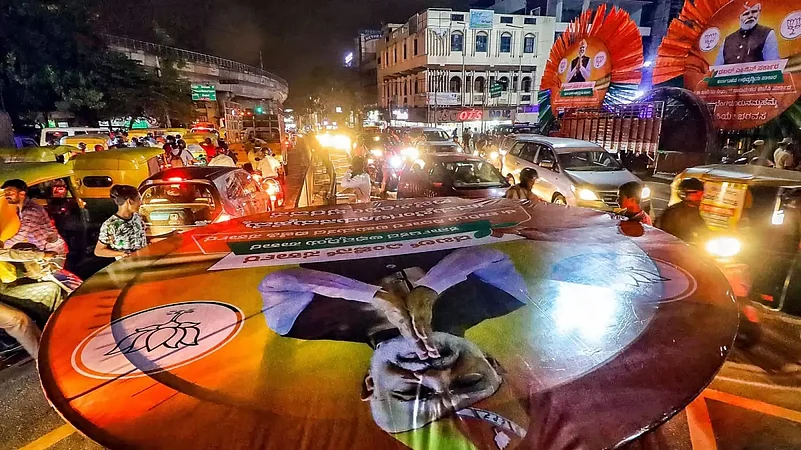The recent Karnataka election results have demonstrated, once again, that if the Opposition parties are serious about winning the electoral struggle of 2024, they must shift the discourse away from large emotive issues that characteristically play on the major fault lines of the Hindu-Muslim divide.
That’s what the Congress campaign attempted to do while eschewing larger national issues and focusing on local issues such as the promise of 200 units of free electricity to every household, Rs 2,000 per month to women heads of families and 10 kg food grains to below-poverty-line families. Existing dissatisfaction against the ‘40 per cent commission’ government run by the BJP also seems to have played an important role in the defeat of the BJP. The message of communal harmony of Rahul Gandhi’s Bharat Jodo Yatra (BJY), his famous ‘mohabbat ki dukan’ was also always playing in the background—after all, the BJY had generated a lot of enthusiasm and received massive support in the state, just months before the elections.
The fact still remains that the Congress leadership decided to focus on issues that concern the everyday lives of people, rather than re-stage, once more, the well-rehearsed ‘secular-communal’ drama, with the BJP inevitably playing the ‘80-20’ card (“we are 80 per cent” as Yogi Adityanath put it). These promises and the welcome shift of the campaign to people’s everyday issues is, in a way, the result of a general political learning among non-BJP parties, especially since the Delhi elections of February 2020. In the case of the Aam Aadmi Party in Delhi, though, the emphasis was never on direct cash transfers or free food grains, but on building and strengthening the health and education infrastructure that would provide these basic amenities to all classes of people.
While communal polarisation was always a standard tactic of the ruling BJP, its deployment as an electoral strategy has become more aggressive in the last few years. During the campaign for the February 2020 elections in Delhi—which took place when the anti-Citizenship Amendment Act (CAA) protests were going on across the country—one was witness to the most bizarre allegations by BJP campaigners like Yogi Adityanath, Amit Shah and Parvesh Verma accusing Arvind Kejriwal of ‘having links with Pakistan’, ‘being a terrorist’ and ‘sponsoring Shaheen Bagh’. This high-decibel campaign was not unrelated to the fact that at one point during the campaign, former Deputy Chief Minister Manish Sisodia had openly declared support to the Shaheen Bagh protest and Kejriwal had opposed the Citizenship Amendment Act. However, as the campaign went ahead, it became increasingly clear that the BJP and its supporters, in some of the media channels, were actually pushing Kejriwal to visit Shaheen Bagh.
That was when the AAP’s campaign began to shift, as its leaders realised that the BJP’s game plan was to link AAP and Kejriwal to a chain of signifiers—like ‘Muslims’, ‘Shaheen Bagh’, ‘Pakistan’, ‘terrorism’, ‘tukde-tukde gang’ and ‘anti-nationals’—thus turning the entire election into a Hindu-Muslim affair. Increasingly, AAP started maintaining silence on such matters and single-mindedly focused on what were its primary campaign issues, namely education, health, water and electricity, where it had a good deal of work to showcase. At the cost of alienating its Muslim supporters and letting down many in ‘civil society’ who had expected the party to take a more forthright position on matters concerning attacks on minority communities, AAP held on steadfastly to its position. The results showed that it had actually managed to foil the BJP’s plan.
The lessons of the Delhi elections were learnt and put to good use in the Mahagathbandhan’s campaign in Bihar later that same year, where it performed very well and managed to shift the focus to every day livelihood issues, foiling the BJP’s attempts at communal polarisation. Tejashwi Yadav, whose rallies drew a spectacular response from voters, underlined that Mahagathbandhan’s focus was on economic and related issues such as unemployment and education. He underlined that the ‘social justice’ plank of an earlier time was insufficient today as the current problems of the state had placed questions such as unemployment and education on top of the agenda.
Unfortunately, from the correct initial strategy of steering clear of the ‘secular-communal’ tango, the AAP leadership seems to have drawn completely erroneous conclusions, as was evident in its attempts to play the Hindu card during the later phase of the anti-CAA movement. From then on, its slide towards a soft-Hindutva stance became alarmingly obvious. Sisodia’s indefensible statement on Sharjeel Imam, AAP’s atrocious stance on the Tablighi Markaz at the height of the Covid pandemic and AAP leaders’ belligerent statements on the hapless Rohingya refugees following the Jahangirpuri violence in April 2022—all went to show that the party was, in fact, buying into the BJP’s narrative in crucial respects and was prepared to dump principles for the sake of competitive communalism and power.
During the Gujarat elections, Kejriwal even went on to demand the printing of Lakshmi and Ganesh’s images on currency notes, in a bid to outdo the BJP on the Hindutva plank. This was an indication of the extent to which electoral opportunism had consumed the party. There are some early signs that the Gujarat elections may have sent home the message to the party that no matter what kind of Hindu card they play, the Hindu plank remains the BJP’s home turf and AAP—or any other party—has little chance of displacing it from there. Only time will tell if this is actually so.
However, the problem does not end there for the Opposition. Focusing on people’s livelihood issues at the state level and avoiding confronting the politics of Hindutva, leaves intact the argument that at the national level, Modi is still indispensable. That is an entirely different ball game. It is not that these economic issues are not important in national politics, but they have to be combined with a different political narrative that must not respond to issues posed by the BJP, but pose an alternative vision.
The fundamental dilemma of modern politics is the problem of ‘constructing the people’. It is not simply about rejecting X or Y, but rather, of producing a positive narrative that unites different sections. Hindutva’s politics is predicated on the production of a supposed Hindu community as ‘The People’; as unified and without any internal differentiation. Given Hinduism’s history, this is impossible. There is perhaps no community so internally divided and hierarchical anywhere in the world. Nonetheless, Hindutva has managed to temporarily construct a seemingly unified Hindu community at least in some parts of India. Once upon a time, the Left had managed to produce the narrative of ‘The People’ as the oppressed, as those who labour—an imagination that cut across identities, which did give the Left a strong presence in some states. The idea even became hegemonic, that is to say, it was accepted even by those who were not Leftists. For a brief period, Kanshi Ram’s idea of the Bahujan as ‘The People’—comprising Dalits, backward castes along with minorities—also caught the imagination of a section of people and became an important mobilisational plank in Uttar Pradesh.
There has always been one more imagination that caught the immense diversity of Indian realities and traditions and spoke of ‘unity in diversity’ without trying to invoke an external ‘other’. It drew on the metaphysical idea of an essential unity behind the apparent diversity. That idea has also been appropriated in Hindutva’s rendering of a ‘tolerant and diverse Hinduism’, which of course, runs alongside its project of homogenisation or samrasta. ‘Unity in diversity’ makes no sense as diversity only within Hindus. Its true meaning can only be realised if it is combined with the defence of the Constitution as the social charter of a new India, where there is social justice across castes and communities.
The outcome of the elections of 2024, after Karnataka, can certainly be steered in this direction. Much will depend on how far the Opposition can raise people’s livelihood-related issues in tandem with a different political narrative.
(Views expressed are personal)
Aditya Nigam is a Delhi-based political theorist


























